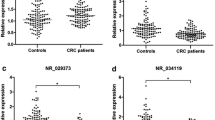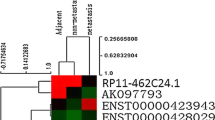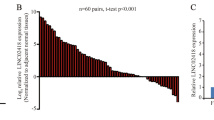Abstracts
In recent years, the role of long noncoding RNAs (lncRNAs) in cancer is increasingly focused. ncRuPAR is a newly detected lncRNA; in previous study, we found out that ncRuPAR could inhibit tumor progression by downregulating protease-activated receptor-1 (PAR-1), but its role in colorectal cancer (CRC) is never elucidated. Here, we conducted a self-control study which includes 105 CRC samples. By quantitative real time PCR (qRT-PCR) and immunohistochemical staining, we detected the expression of ncRuPAR and PAR-1 as well as their correlation; we further associated these data with the clinicopathologic parameters. A receiver operating characteristic (ROC) curve was constructed to evaluate the diagnostic value of ncRuPAR and PAR-1, respectively. Our results indicated that the expression of ncRuPAR was significantly downregulated in CRC compared with paired adjacent nontumor tissues, but the level of PAR-1 mRNA in cancerous tissues was significantly higher than in adjacent normal areas. The expression of ncRuPAR was significantly correlated with lymph node metastasis, distant metastasis, Duck’s stage, differentiation, and TNM stage and was potentially negatively associated with the mRNA levels and EI scores of PAR-1. The area under the ROC curve of ncRuPAR was 0.81 (95 % confidence interval (CI): 0.75–0.87); at a cutoff value of 8.34, the ncRuPAR measurement had a sensitivity of 97.14 %, a specificity of 65.87 %, and an accuracy of 82.86 % to predict CRC.



Similar content being viewed by others
References
Zafar SY, Malin JL, Grambow SC, et al. Chemotherapy use and patient treatment preferences in advanced colorectal cancer: a prospective cohort study. Cancer. 2013;119(4):854–62.
Kelley RK, Wang G, Venook AP. Biomarker use in colorectal cancer therapy. J Natl Compr Canc Netw. 2011;9(11):1293–302.
Cai SB, Zhang X, Chen ZX, et al. Medicated serum prepared with Chinese herbal medicine Zhizhen Recipe down-regulates activity of nuclear factor-κB and expression of P-glycoprotein in human colorectal cancer multidrug-resistant cell line HCT-8/VCR. Zhong Xi Yi Jie He Xue Bao. 2011;9(12):1353–9.
Krzyzanowski PM, Muro EM, Andrade-Navarro MA. Computational approaches to discovering noncoding RNA. Wiley Interdiscip Rev RNA. 2012;3(4):567–79.
Muers M. RNA: genome-wide views of long non-coding RNAs. Nat Rev Genet. 2011;12(11):742.
Wilusz JE, Sunwoo H, Spector DL. Long noncoding RNAs: functional surprises from the RNA world. Genes Dev. 2009;23(13):1494–504.
Guttman M, Donaghey J, Carey BW, et al. lincRNAs act in the circuitry controlling pluripotency and differentiation. Nature. 2011;477(7364):295–300.
Lee JT. The X, as model for RNA’s niche in epigenomic regulation. Cold Spring Harb Perspect Biol. 2010;2(9):a003749.
Huarte M, Guttman M, Feldser D, et al. A large intergenic noncoding RNA induced by p53 mediates global gene repression in the p53 response. Cell. 2010;142(3):409–19.
Nagano T, Fraser P. No-nonsense functions for long noncoding RNAs. Cell. 2011;145(2):178–81.
Prensner JR, Iyer MK, Balbin OA, et al. Transcriptome sequencing across a prostate cancer cohort identifies PCAT-1, an unannotated lincRNA implicated in disease progression. Nat Biotechnol. 2011;29(8):742–9.
Lai MC, Yang Z, Zhou L, et al. Long non-coding RNA MALAT-1 overexpression predicts tumor recurrence of hepatocellular carcinoma after liver transplantation. Med Oncol. 2012;29(3):1810–6.
Braconi C, Kogure T, Valeri N, et al. microRNA-29 can regulate expression of the long non-coding RNA gene MEG3 in hepatocellular cancer. Oncogene. 2011;30(47):4750–6.
Gupta RA, Shah N, Wang KC, et al. Long non-coding RNA HOTAIR reprograms chromatin state to promote cancer metastasis. Nature. 2010;464(7291):1071–6.
Huang JF, Guo YJ, Zhao CX, et al. HBx-related lncRNA Dreh inhibits hepatocellular carcinoma metastasis by targeting the intermediate filament protein vimentin. Hepatology. 2013;57(5):1882–92.
Liu L, Yan B, Yang Z, et al. ncRuPAR inhibits gastric cancer progression by down-regulating protease-activated receptor-1. Tumour Biol. 2014.
Edge SB, Byrd DR, Compton CC, et al. AJCC Cancer Staging Manual. 7th ed. New York: Springer; 2009. p. 347–76.
Sarela AI, Verbeke CS, Ramsdale J, et al. Expression of survivin, a novel inhibitor of apoptosis and cell cycle regulatory protein, in pancreatic adenocarcinoma. Br J Cancer. 2002;86(6):886–92.
Barbareschi M, Maisonneuve P, Aldovini D, et al. High syndecan-1 expression in breast carcinoma is related to an aggressive phenotype and to poorer prognosis. Cancer. 2003;98(3):474–83.
Yang F, Bi J, Xue X, et al. Up-regulated long non-coding RNA H19 contributes to proliferation of gastric cancer cells. FEBS J. 2012;279(17):3159–65.
Lee SR, Kim HO, Shin JH, et al. Prognostic significance of quantitative carcinoembryonic antigen and cytokeratin 20 mRNA detection in peritoneal washes of gastric cancer patients. Hepatogastroenterol. 2013;60(125):1237–44.
Yoshimizu T, Miroglio A, Ripoche MA, et al. The H19 locus acts in vivo as a tumor suppressor. Proc Natl Acad Sci U S A. 2008;105(34):12417–22.
Matouk IJ, DeGroot N, Mezan S, et al. The H19 non-coding RNA is essential for human tumor growth. PLoS ONE. 2007;2(9):e845.
Dorsam RT, Gutkind JS. G-protein-coupled receptors and cancer. Nat Rev Cancer. 2007;7(2):79–94.
Even-Ram S, Uziely B, Cohen P, et al. Thrombin receptor overexpression in malignant and physiological invasion processes. Nat Med. 1998;4(8):909–14.
Darmoul D, Gratio V, Devaud H, et al. Aberrant expression and activation of the thrombin receptor protease-activated receptor-1 induces cell proliferation and motility in human colon cancer cells. Am J Pathol. 2003;162(5):1503–13.
Daaka Y. G proteins in cancer: the prostate cancer paradigm. Sci STKE. 2004;2004(216):re2.
Stanbridge EJ. Identifying tumor suppressor genes in human colorectal cancer. Science. 1990;247(4938):12–3.
Nault JC, Zucman-Rossi J. Genetics of hepatobiliary carcinogenesis. Semin Liver Dis. 2011;31(2):173–87.
Kanwal R, Gupta S. Epigenetic modifications in cancer. Clin Genet. 2012;81(4):303–11.
Madamanchi NR, Hu ZY, Li F, et al. A noncoding RNA regulates human protease-activated receptor-1 gene during embryogenesis. Biochim Biophys Acta. 2002;1576(3):237–45.
Hanahan D, Weinberg RA. Hallmarks of cancer: the next generation. Cell. 2011;144(5):646–74.
Wang WJ. Enhancing the treatment of metabolic syndrome with integrative medicine. J Integr Med. 2013;11(3):153–6.
Acknowledgments
This work was supported by the National Natural Science Foundation of China (Grants 81102693 and 81102565).
Author information
Authors and Affiliations
Corresponding author
Additional information
Bing Yan, Wei Gu, Zhihui Yang, Zhan Gu, and Long Liu contribute equally to the work.
Rights and permissions
About this article
Cite this article
Yan, B., Gu, W., Yang, Z. et al. Downregulation of a long noncoding RNA-ncRuPAR contributes to tumor inhibition in colorectal cancer. Tumor Biol. 35, 11329–11335 (2014). https://doi.org/10.1007/s13277-014-2465-0
Received:
Accepted:
Published:
Issue Date:
DOI: https://doi.org/10.1007/s13277-014-2465-0




